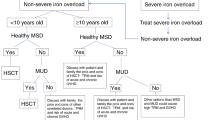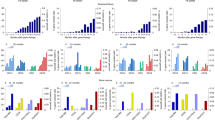Abstract
The first hematopoietic cell transplants in humans with durable success were reported in 1968, in three patients with primary immunodeficiencies who received grafts from HLA-matched siblings (two with SCID and one with Wiskott–Aldrich syndrome). Significant progress has been made in correcting lethal primary immunodeficiencies (PIDs) with hematopoietic transplantation in the ensuing 40 years due to several factors: (1) ability to phenotype and quantitate (CD34+) hematopoietic stem cells, (2) advent of high-resolution tissue typing, (3) availability of closely matched unrelated donor bone marrow, peripheral blood stem cells, and cord blood, and (4) the application of reduced intensity conditioning regimens pre-transplant. Furthermore, the genetic basis of the majority of lethal PIDs has been defined, allowing more accurate studies of the natural history of the disorders without HCT intervention, and providing a compelling rationale for early transplantation in disorders with median survivals of 15–20 years. In the current era, we can identify several factors, which influence the ultimate success of HCT for PID. These include the age at transplant and general health of the patient. Young age is associated with fewer comorbidities and less frequent pre-transplant exposure to herpes family and enteric viruses, thus lowering the risks of related post-transplant complications. The careful selection of pre-transplant conditioning can significantly reduce early TRM in patients with certain immunodeficiencies, and increase the probability of durable engraftment in others. Because of the specific needs of children with PIDs, HCT from unrelated donors should, ideally, be performed in centers with extensive expertise and experience in the treatment of such disorders. In such centers, donor selection based on high-resolution tissue typing, younger age and specific viral immunity has led to survival rates following matched unrelated donor HCT for PIDs, which are very similar to those obtained with HCT from matched sibling donors. While ultimate success rates are similar, transplant-related management of children receiving unrelated grafts is considerably more complicated and prolonged than following matched sibling HCT.
This is a preview of subscription content, access via your institution
Access options
Subscribe to this journal
Receive 12 print issues and online access
$259.00 per year
only $21.58 per issue
Buy this article
- Purchase on Springer Link
- Instant access to full article PDF
Prices may be subject to local taxes which are calculated during checkout
Similar content being viewed by others
References
Myers LA, Patel DD, Puck JM, Buckley RH . Hematopoietic stem cell transplantation for severe combined immunodeficiency in the neonatal period leads to superior thymic output and improved survival. Blood 2002; 99: 872–878.
Antoine C, Muller S, Cant A, Cavazzana-Calvo M, Veys P, Vossen J et al. Long-term survival and transplantation of haemopoietic stem cells for immunodeficiencies: report of the European Experience 1968–99. Lancet 2003; 361: 553–560.
Laffort C, Le Deist F, Favre M, Caillat-Zucman S, Radford-Weiss I, Debre M et al. Severe cutaneous papillomavirus disease after haemopoietic stem-cell transplantation in patients with severe combined immune deficiency caused by common gamma cytokine receptor subunit or JAK-3 deficiency. Lancet 2004; 363: 2051–2054.
Chan K, Puck JM . Development of population-based newborn screening for severe combined immunodeficiency. J Allergy Clin Immunol 2005; 115: 391–398.
Grunebaum E, Somech R, Reid B, Roifman Chaim M . Survival and immune function in patients with severe combined immune deficiency after bone marrow transplantation from matched unrelated donors, Proceedings of the XIIth Meeting of ESID, October 2006 page 68.
Filipovich AH, Stone J, Tomany SC, Ireland M, Kollman C, Pelz CJ et al. Impact of donor type on outcome of bone marrow transplantation for Wiskott–Aldrich syndrome: collaborative study of the International Bone Marrow Transplant Registry and the National Marrow Donor Program. Blood 2001; 97: 1598–1603.
Gennery AR, Khawaja K, Veys P, Bredius RG, Notarangelo LD, Mazzolari E et al. Treatment of CD40 ligand deficiency by hematopoietic stem cell transplantation: a survey of the European Experience 1993–2002. Blood 2003; 103: 1152–1157.
Del Giudice I, Iori AP, Mengarelli A, Testi AM, Romano A, Cerretti R et al. Allogenic stem cell transplant from HLA-identical sibling for chronic granulomatous disease and review of literature. Ann Hematol 2003; 82: 189–192.
Lankester AC, Visser LF, Hartwig NG, Bredius RG, Gaspar HP, van der Burg M et al. Allogeneic stem cell transplantation in X-linked lymphoproliferative disease: two cases in one family and review of the literature. Bone Marrow Transplant 2005; 36: 99–105.
Rao A, Kamani N, Filipovich AH, Lee SM, Davies S, Dalal J, Shenoy S . Successful bone marrow transplantation for IPEX syndrome following reduced- intensity conditioning. Blood 2007; 109: 383–385.
Horne AC, Janka G, Egeler RM, Gadner H, Imashuku S, Ladisch S et al. Hematopoietic stem cell transplantation in hemophagocytic lymphohistiocytosis: results of the HLH-94 Study. Br J Haematol 2005; 129: 622–630.
Eapen M, DeLaat C, Baker S, Cairo M, Cowan M, Kurtzberg J et al. Hematopoietic cell transplantation for Chediak–Higashi syndrome. Bone Marrow Transplant 2007; 39: 411–415.
Tardieu M, Lacroix C, Neven B, Bordiogoni P, de Saint Basil G, Blanche S et al. Progressive neurologic dysfunctions 20 years after allogenic bone marrow transplantation for Chediak–Higashi syndrome. Blood 2005; 106: 40–42.
Neven B, Mahlaoui N, Picard C, Ouachee M, Le Deist F, Cavazzana-Calvo M et al. Long-term follow-up in a large cohort of patients with severe combined immunodeficiency, Proceedings of the XIIth Meeting of ESID, October 2006, page 68.
Rao K, Amrolia PJ, Jones A, Cale CM, Naik P, King D et al. Improved survival after unrelated donor bone marrow transplantation in children with primary immunodeficiency using a reduced-intensity conditioning regimen. Blood 2005; 105: 879–885.
Borghans JA, Bredius RG, Hazenberg MD, Roelofs H, Jol-van der Zijde EC, Heidt J et al. Early determinants of long-term T-cell reconstitution after hematopoietic stem cell transplantation for severe combined immunodeficiency. Blood 2006; 108: 763–769.
Author information
Authors and Affiliations
Corresponding author
Rights and permissions
About this article
Cite this article
Filipovich, A. Hematopoietic cell transplantation for correction of primary immunodeficiencies. Bone Marrow Transplant 42 (Suppl 1), S49–S52 (2008). https://doi.org/10.1038/bmt.2008.121
Published:
Issue Date:
DOI: https://doi.org/10.1038/bmt.2008.121
Keywords
This article is cited by
-
Inherited CARD9 Deficiency: Invasive Disease Caused by Ascomycete Fungi in Previously Healthy Children and Adults
Journal of Clinical Immunology (2018)
-
Increase of bone marrow macrophages and CD8+ T lymphocytes predict graft failure after allogeneic bone marrow or cord blood transplantation
Bone Marrow Transplantation (2017)
-
Lymphopoiesis in transgenic mice over-expressing Artemis
Gene Therapy (2016)
-
Early CD3+/CD15+ peripheral blood leukocyte chimerism patterns correlate with long-term engraftment in non-malignant hematopoietic SCT
Bone Marrow Transplantation (2014)
-
Delayed platelet recovery after allogeneic transplantation: a predictor of increased treatment-related mortality and poorer survival
Bone Marrow Transplantation (2011)



